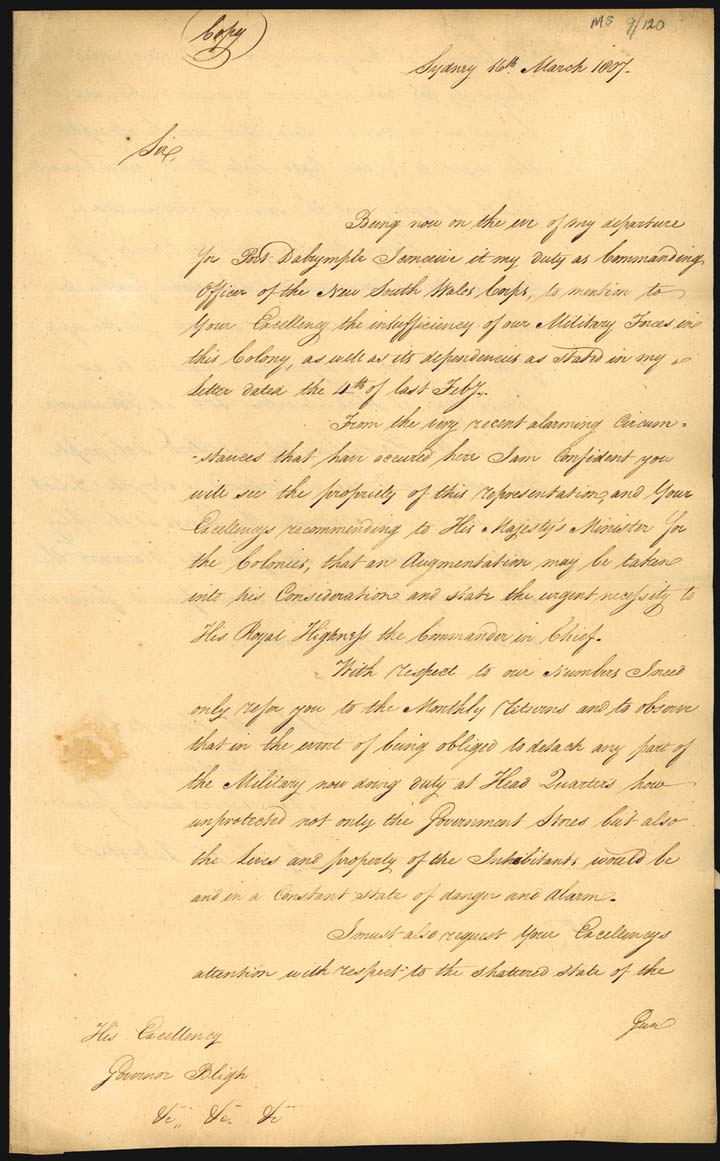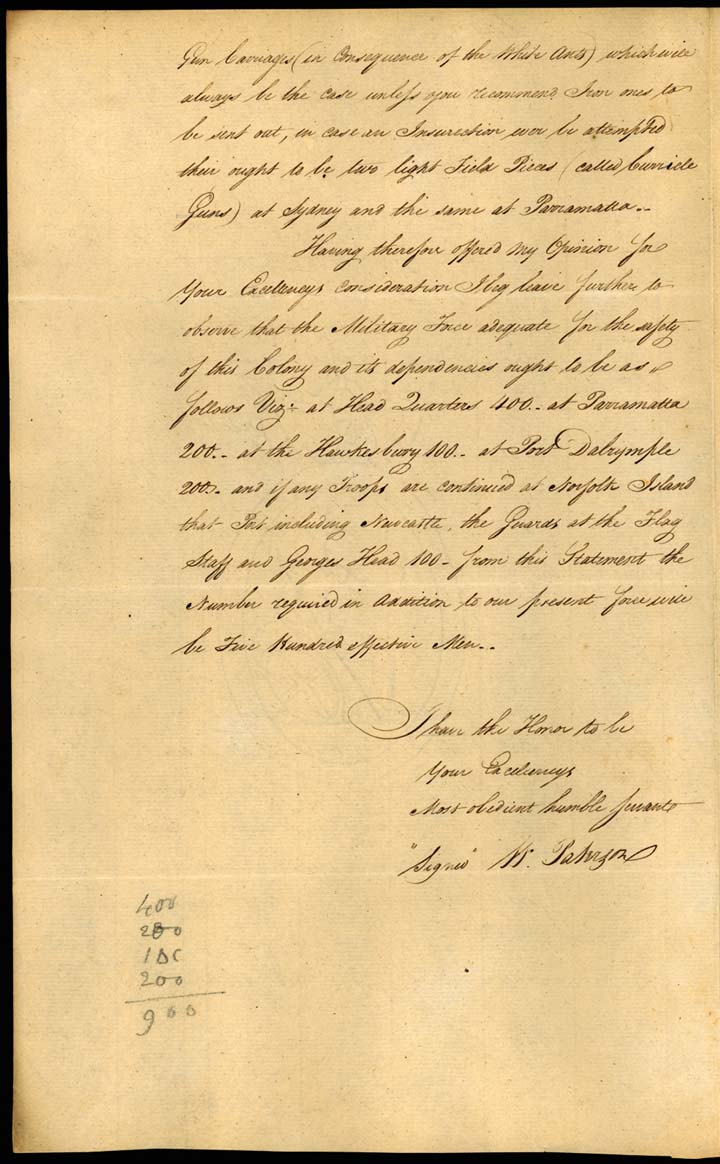Description
This is a copy of a letter written on 16 March 1807 by William Paterson, commander of the New South Wales Corps, to William Bligh, Governor of the British colony of New South Wales, repeating an 'urgent' call for a big boost in the Corps' numbers, and asking for it to be equipped with iron guncarriages. This copy was sent by Paterson to the British naturalist, Sir Joseph Banks.
![]() Further information is available for this resource.
Further information is available for this resource.
Educational value
- This asset relates to the New South Wales Corps, a military force specially raised in England to serve in the new colony of NSW from 1792 - officers of the Corps soon gained significant land holdings and control over trade, especially of spirits (known generally as 'rum'), prompting the nickname 'the Rum Corps'; on 26 January 1808, in Australia's only military coup (which was later known as the 'rum rebellion'), the Corps deposed Governor Bligh (1754-1831) after he challenged their entrenched power, and ruled the colony until it was disbanded in 1810 by a new Governor, Lachlan Macquarie (1762-1824), who arrived from Britain with his own regiment.
- It names the locations where military forces were deployed in NSW in 1807 - more details are given in an accompanying enclosure sent on to London with Paterson's letter; this enclosure states that, at the time, there were 480 'rank and file' troops in the colony, the biggest concentrations being at the military headquarters in Sydney (266), Parramatta (74), and Port Dalrymple (63); Port Dalrymple was an isolated settlement established by Paterson in 1804 on the estuary of the Tamar River in the north of Van Diemen's Land (Tasmania), near present-day Launceston (Tasmania).
- It shows the level of concern about the fragile security situation in the early period of European settlement of Australia and the possibility of insurrection - the 'very recent alarming circumstances' referred to by Paterson could be an uprising by Irish prisoners in Sydney in 1804 (the Castle Hill Rebellion or Battle of Vinegar Hill), that resulted in 15 being killed by the NSW Corps and a militia force, and a further nine being hanged.
- It mentions guncarriages - these were two-wheeled carts carrying artillery guns, drawn by two horses; the frames and wheels of the carriages initially sent to NSW were wooden, making them susceptible to 'white ant' (termite) attack; a separate enclosure sent to London with Paterson's letter shows that by 1806 most of the carriages in the colony were regarded as 'unfit for service'.
- It provides an example of the problems early administrators of the colony of NSW had with very limited discretionary spending powers - colonial governors had wide discretionary powers on dealing with day-to-day issues, but all major expenditure decisions had to be authorised in London, a process that would take months, with ships having to carry letters each way; when Governor William Bligh passed on Paterson's letter to London, he addressed it to William Windham (1750-1810), having no way of knowing that, with a change of British Government more than six months earlier, Windham was no longer the Secretary of State for War and the Colonies.
- It is an example of a communication from Scottish-born military officer and explorer William Paterson (1755-1810) - Paterson arrived in Sydney as a captain of the NSW Corps in 1791, and served as administrator of the colony (1794-95), Lieutenant-Governor (1801-09) and Acting Governor (1809-10); he died at sea off Cape Horn on his way back to Britain in 1810.
- It is an example of a communication to William Bligh, a controversial naval officer who was Governor of NSW from 1806 to 1808 - ironically, when he forwarded Paterson's letter to London in 1807, Bligh endorsed his request for more troops 'in the strongest manner', not realising that less than a year later the Corps itself would overthrow him; Bligh eventually went back to England in 1810, and was promoted to rear-admiral and then vice-admiral in the Royal Navy.
- It relates to Sir Joseph Banks (1743-1820), a wealthy naturalist and patron of science who has been called the 'Father of Australia' - Banks was with Lieutenant James Cook (1728-79) when he claimed the east coast of Australia on behalf of Britain in 1770, and for years remained a key advisor to British governments on matters relating to Australia, helping both Paterson and Bligh to obtain their appointments in NSW; a portrait of Banks has been used on Australia's $5 note.

